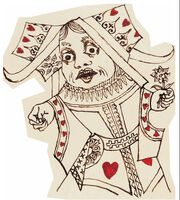| The Queen of Hearts | |
|---|---|
 | |
|
Real Name |
Queen of Hearts |
|
First Appearance |
Unknown |
|
Created by |
Unknown |
Origin[]
"The Queen of Hearts" is a poem based on the characters found on playing cards, by an anonymous author, originally published in the British publication The European Magazine, vol. 1, no. 4, in April, 1782. Lewis Carroll later developed characters from the nursery rhyme into his own story, Alice's Adventures in Wonderland.
"The Queen of Hearts" relates that the Queen of Hearts bakes some tarts which the Knave of Hearts steals. The King of Hearts has the Knave punished, so he brings them back and pledges not to steal again.
- The queen of hearts,
- She made some tarts,
- All on a summer’s day;
- The knave of hearts
- He stole those tarts,
- And with them run away;
- The king of hearts
- Call’d for those tarts,
- And beat the knave full sore;
- The knave of hearts
- Brought back those tarts,
- And said he’ll ne’er steal more.
Although it was originally published in a magazine for adults, it eventually became best known as a nursery rhyme and by 1785 had been set to music.

The Queen of Hearts as depicted by Lewis Carroll.
Wonderland[]
Alice observes three playing cards painting white roses red. They drop to the ground face down at the approach of the Queen of Hearts, whom Alice has never met. When the Queen arrives and asks Alice who is lying on the ground (since the backs of all playing cards look alike), Alice tells her that she does not know. The Queen then becomes frustrated and commands that her head be severed. She is deterred by her comparatively moderate husband by being reminded that Alice is only a child.
Generally, however, as we are told by Carroll:
- "The Queen had only one way of settling all difficulties, great or small. 'Off with his head!' she said, without even looking round."
One of the Queen's hobbies - besides ordering executions - is croquet, however it is Wonderland croquet, where the balls are live hedgehogs and the mallets are flamingos. This is presumably with the aim that the birds' blunt beaks should strike, but, as Alice observes, it is complicated by the fact that they keep looking back up at the players- as well as the hedgehogs' tendency to scuttle away without waiting to be hit. The Queen's soldiers act as the arches (or hoops) on the croquet grounds, but have to leave off being arches every time the Queen has an executioner drag away the victim, so that, by the end of the game in the story, the only players that remain are the Queen herself, the King, and Alice.
Despite the frequency of death sentences, it would appear few people are actually beheaded. The King of Hearts quietly pardons many of his subjects when the Queen is not looking (although this did not seem to be the case with The Duchess), and her soldiers humor her but do not carry out her orders. The Gryphon tells Alice that "It's all her fancy: she never executes nobody, you know." Nevertheless, all creatures in Wonderland fear the Queen. In the final chapters, the Queen sentences Alice again (for defending the Knave of Hearts) and she offers a bizarre approach towards justice: sentence before verdict.
She and the King also have ten children (the numerical hearts suit of cards).
Notes[]
- Queens began to appear in French playing cards and in tarot decks in the 1400s. The Queen of Hearts’ counterpart in the tarot deck is the Queen of Cups. The French associate the Queen of Hearts (Dame de Cœur) with the Biblical/Apocryphal character Judith, coincidentally associated with beheading as much as Carroll’s Queen of Hearts is.
- She is commonly mistaken for the Red Queen in the story's sequel, Through the Looking-Glass however, the Queen of Hearts is a playing card and the Red Queen is a chess piece.